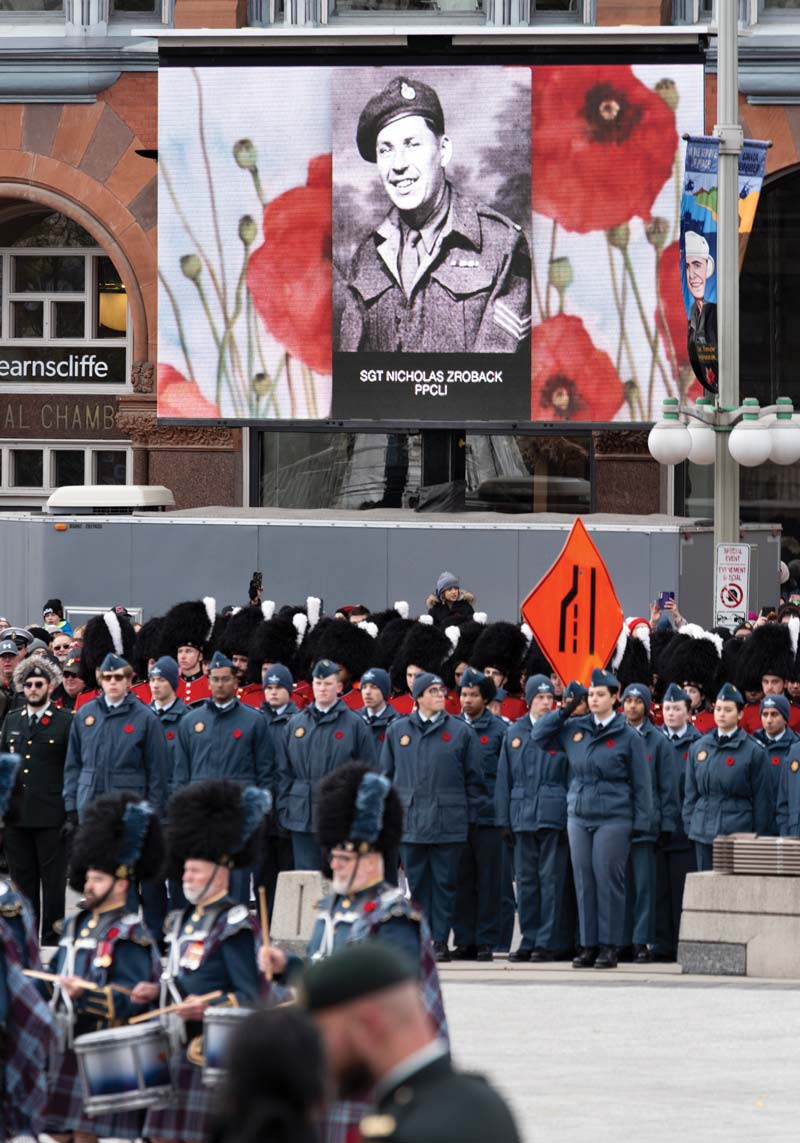The heartbeat of Canada was heard along Ottawa’s Elgin Street, played at a steady rhythm by the Central Band of the Canadian Armed Forces. Throngs of people gathered around the National War Memorial on a cold, bright morning, rosy-cheeked and shivering in silent anticipation for Ottawa’s 2023 Remembrance Day ceremony. Some stood behind the barriers, while others sat on the rooftops of nearby office buildings, each attendee with their own story about how the CAF’s lifeblood invariably mixed with theirs.
As Elgin filled with military branches and members of all kinds, there was diverse representation throughout this year’s national event, marked by new campaigns, new language and new faces. The unofficial theme was fitting, too, in conjunction with acknowledging the 75th anniversary of peacekeeping, a reminder of the military’s many functions and sacrifices. Plus, with topics such as mental health, service families, Indigenous representation and more featured in speeches, the capital’s ceremony intimated that the act of remembrance is for everyone.
When the massed pipes and drums reached the National War Memorial and fell silent, the sun dipped behind the clouds as the official ceremony began. Present were the speaker of the Senate Raymonde Gagné, Minister of Veterans Affairs Ginette Petitpas Taylor and defence chief General Wayne Eyre, along with this year’s top cadets and the senior winners of The Royal Canadian Legion’s poster and literary contests. The crowd stood still, waiting for the arrival of special guests, including Governor General Mary Simon, Prime Minister Justin Trudeau and 2023 National Memorial (Silver) Cross Mother Gloria Hooper. Hooper’s son Christopher (Chris) Holopina was the first Canadian peacekeeper killed on duty during the country’s 1990s mission in Bosnia.
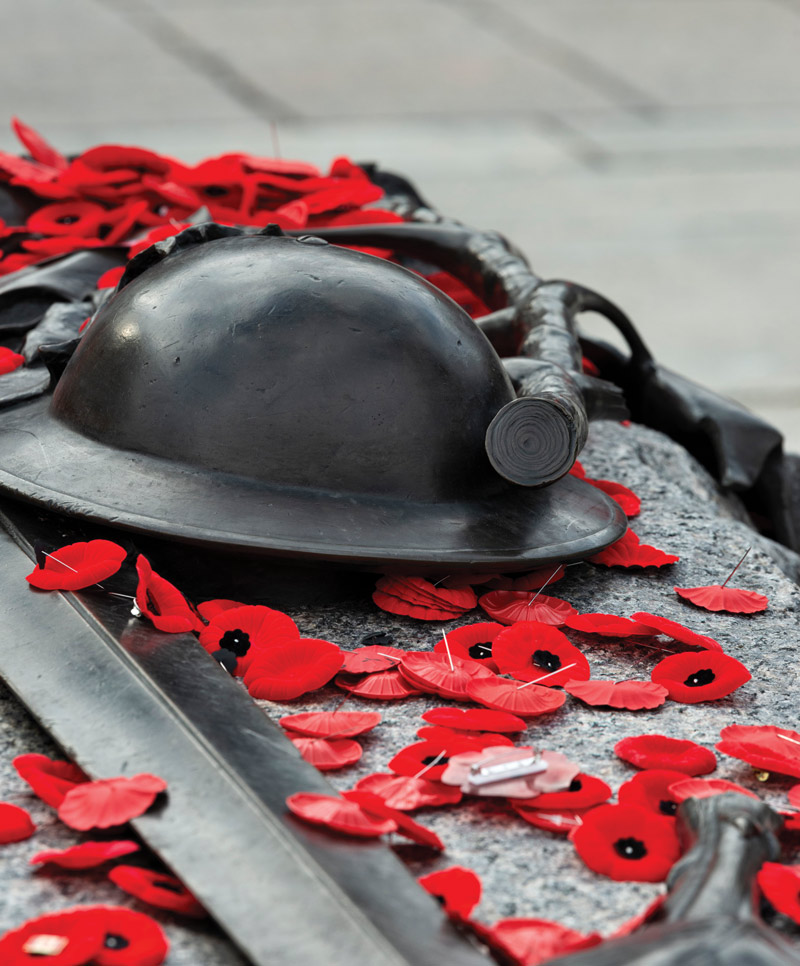
Poppies cover the Tomb of the Unknown Soldier. [Marc Fowler + Melody Maloney/Metropolis Studio]
A fun-loving prankster born in Russell, Man., Holopina’s childhood interests included toy soldiers, doodling and general mischief. “Anything we could do for fun, we did it!” said Hooper. Enthralled by the military as a youngster, Holopina joined the reserves at 16, eventually becoming a sapper for 2 Combat Engineer Regiment based in Petawawa, Ont.
Serving in Cyprus and Croatia throughout the early to mid-90s, Holopina died in a vehicle accident during his tour in Bosnia while enroute to rescue British soldiers stranded in a minefield. Representing all military parents and their families, Hooper was honoured to symbolically support those who have struggled with “the feeling of having a child gone.”
And just as Hooper remembered her son, thousands of attendees recalled their parents, grandparents and aunts and uncles in the CAF. For Louise and David Doucette of Yarmouth, N.S., that recognition couldn’t be more welcome. “People should remember the big sacrifice veterans’ families went through,” said David.
While the families of military members are often forgotten about during policy-making, veteran health discussions and more, Louise said she’s noticed greater steps toward including military families in CAF decisions. “It’s nice to see everybody included,” she said. “The more inclusion the better. It seems to be more inclusive now than it was even 10 years ago.”
Louise’s father Marc d’Entremont served for four years during the Second World War, including helping to liberate the Netherlands. He brought the war back home with him, however, likely suffering from what we know today as post-traumatic stress disorder. “When he heard gunshots on TV, he had to go outside,” recalled Louise.
d’Entremont died when Louise was only nine years old, and he never had the opportunity to attend the national Remembrance Day ceremony. Holding a laminated picture of her father close to her heart, Louise noted that thanks to her trip to Ottawa, “he is attending right now.”

The national Remembrance Day ceremony attracted a crowd including veterans and serving members.[Marc Fowler + Melody Maloney/Metropolis Studio]
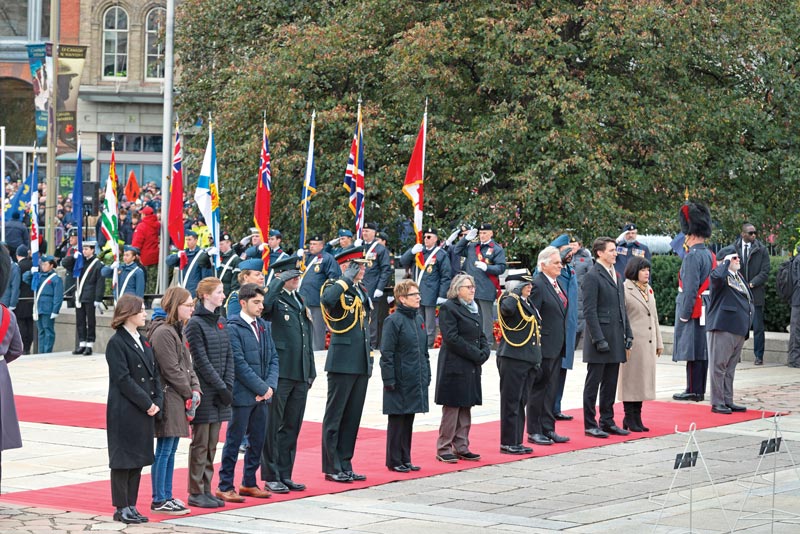
The event’s special guests greet the parade. [Marc Fowler + Melody Maloney/Metropolis Studio]
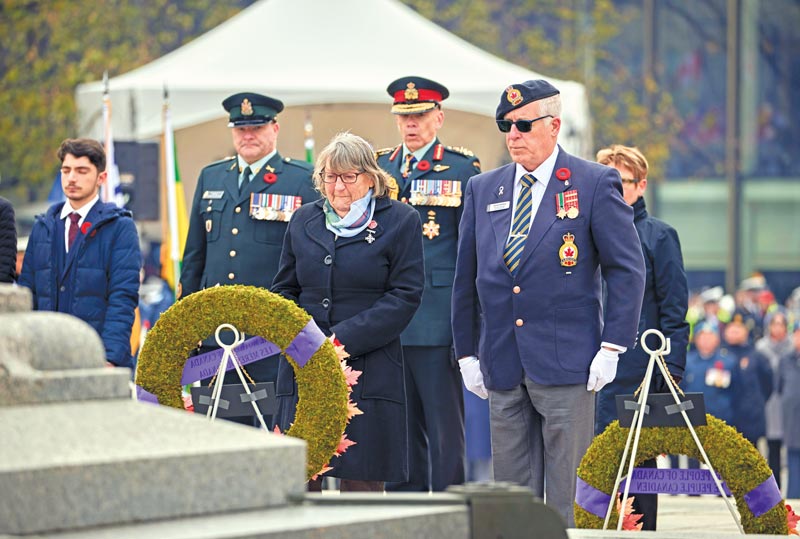
Gloria Hooper (middle), the 2023 National Memorial (Silver) Cross Mother, pauses to reflect after placing a wreath. [Marc Fowler + Melody Maloney/Metropolis Studio]
Hooper was honoured to symbolically support those who have struggled with “the feeling of having a child gone.”
After the special guests arrived, the Ottawa Children’s Choir and the Central Band performed “O Canada,” which was followed by “Last Post.” As Master Corporal James Langridge performed the solemn tune on his trumpet, the first shot of a 21-gun salute was fired by the 30th Field Regiment, Royal Canadian Artillery. And while the Royal Canadian Air Force’s CF-18 Hornets couldn’t perform a flypast due to weather conditions, silhouettes of birds, rattled by the shots, took to the skies in their own aerial display.
After the lilting “Lament” and “The Rouse,” the Act of Remembrance was recited in English by the Legion Dominion President Bruce Julian, in French by the Legion Grand President Larry Murray and in Ojibwe by Chief Petty Officer 2nd Class Patrick Stevens. For Algonquin-born attendees Maria Wabie and Jennifer Thivierge of Notre-Dame-du-Nord, Que., the inclusion of Indigenous language and military members held special significance.
“It’s the uniform and how you act in it that makes you a soldier.”
“It’s an amazing feeling to see that representation,” said Wabie, whose uncle served in the Korean War. “I literally have tears in my eyes just thinking about it. Our people are fighting for our freedom.”
“I didn’t hear a lot about Indigenous military members in the past,” said Thivierge, whose family has served in the Canadian military for multiple generations. “It means a lot. More people are coming to the Remembrance Day service. A lot of younger members in our community are joining.”
Wabie and Thivierge also noted that the greater Indigenous representation in national events gives them a stronger sense of cultural pride and confidence. “We’re learning our culture again,” said Wabie, an education assistant. “When we did the ceremony at our school, we sang ‘O Canada’ in Algonquin.”
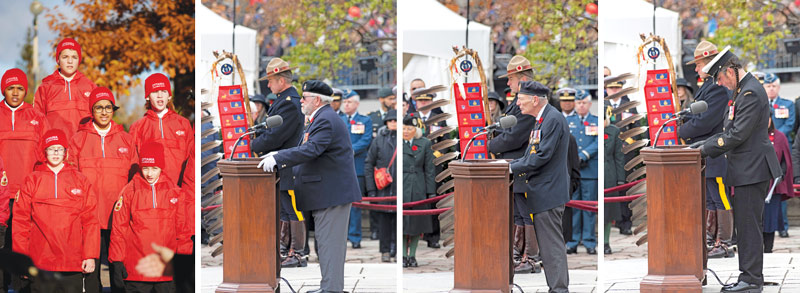
Members of the Ottawa Children’s Choir; Legion Dominion President Bruce Julian; Legion Grand President Larry Murray; Chief Petty Officer 2nd Class Patrick Stevens; cadets gather under the virtual “wall of honour;” a young attendee; Chaplain General Guy Bélisle; Royal Canadian Legion national poster and literary contest winners.[Marc Fowler + Melody Maloney/Metropolis Studio]
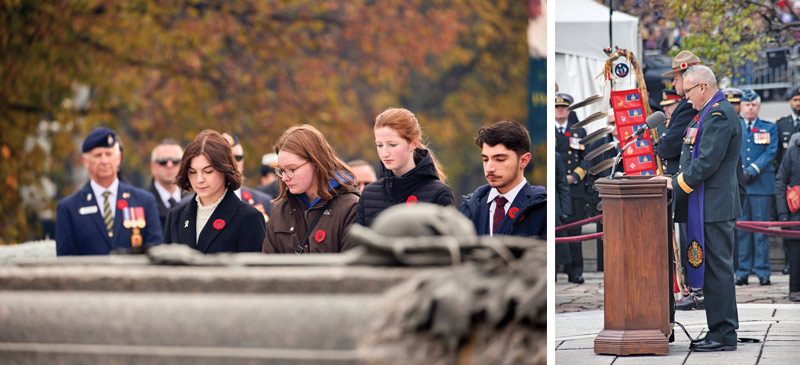
Following the Act of Remembrance, Chaplain General Guy Bélisle began prayers, a feature of the ceremony that fell under some scrutiny. Bélisle had issued a directive a month earlier that dissuaded military chaplains from using “God language” in public ceremony, and the decision received some criticism, including from Roman Catholic Bishop Scott McCaig, a member of the Interfaith Committee on Canadian Military Chaplaincy.
While the directive’s intent was to ensure greater inclusion of faith- and non-faith participants during events, a temporary ban was placed on the new guideline. In fact, McCaig didn’t shy away from overtly religious language during this year’s benediction, emphasizing the importance of enjoying “religious liberty to live both privately and publicly.”
Ceremony attendee Chief Petty Officer 1st Class Adam Thibodeau, however, believed the controversy shouldn’t undermine inclusivity’s importance. “Diversity goes a long way in future warfare,” he said. “If we’re always single-minded and not creating an inclusive atmosphere, then we’ll never have the people to help us win that next battle and next war.
“If you haven’t got diversity and inclusivity, you aren’t embracing all the goodness out there,” observed Thibodeau, who has experienced numerous foreign cultures during 36 years of service. “It’s the uniform and how you act in it that makes you a soldier.”
Originally from Plaster Rock, N.B., Thibodeau comes from a family with a rich military history; both his grandfathers served in the Second World War. Grandfather Donald Alexander received the Bronze Cross from Queen Wilhelmina for his service in the Netherlands.
Thibodeau noted he is satisfied with the CAF’s strides toward diversity and inclusivity, but said he would like to see children more involved in Ottawa’s Remembrance Day, especially since they hold such a special place in the memories of soldiers. “The image of children waving has a lot of meaning to people in uniform,” said Thibodeau, recalling youngsters he had met during work in Rwanda.
“Often when people are waving to you in operations, as opposed to just staring you down or looking the other way,” he continued, “it means that you’re in a safe place, and you’re amongst friends.”
After the dignitaries placed wreaths, the Ottawa Children’s Choir marked the end of the 2023 national Remembrance Day ceremony with “God Save the King.” As the sun emerged from the clouds, a line from the benediction stood out in capturing the essence of the event: “When we look at our veterans,” said Bishop McCaig, “we are looking at the very best of Canada.”
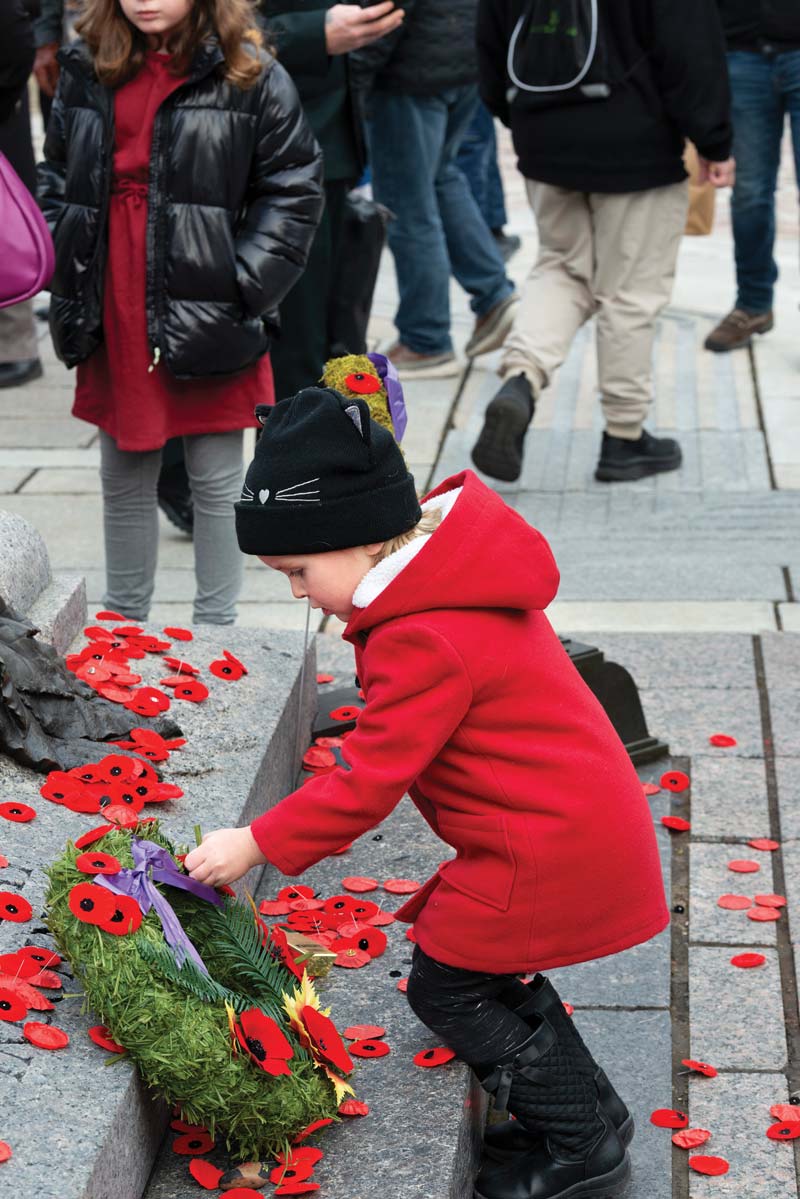
Truly National
The Royal Canadian Legion’s national headquarters organizes the country’s official Remembrance Day ceremony and in doing so, it continues to integrate aspects that help people across the country feel part of it.
This year, for instance, in addition to the virtual “poppy drop,” in which falling poppy images were projected onto the Centre Block of Parliament Hill from late October until Nov. 11, other iconic sites across the country were lit red during the same period in symbolic remembrance, including Toronto’s CN Tower, Niagara Falls, Vancouver’s BC Place Stadium, the Calgary Tower and the Samuel De Champlain Bridge in Montreal.
Legion HQ also organized a virtual “wall of honour,” which projected the images of more than 2,400 deceased veterans from across the country on large video screens near the National War Memorial before the ceremony.
And this year for the first time, the Legion collaborated with national advertisers to have thousands of digital signs across the country share a Remembrance Day message at 11 a.m. on Nov. 11 for two minutes.
Said Legion Dominion President Bruce Julian: “We hope this initiative will help remind people no matter where they may be at that moment of how important it is to remember the sacrifices of our fallen Canadian veterans.”
Advertisement









